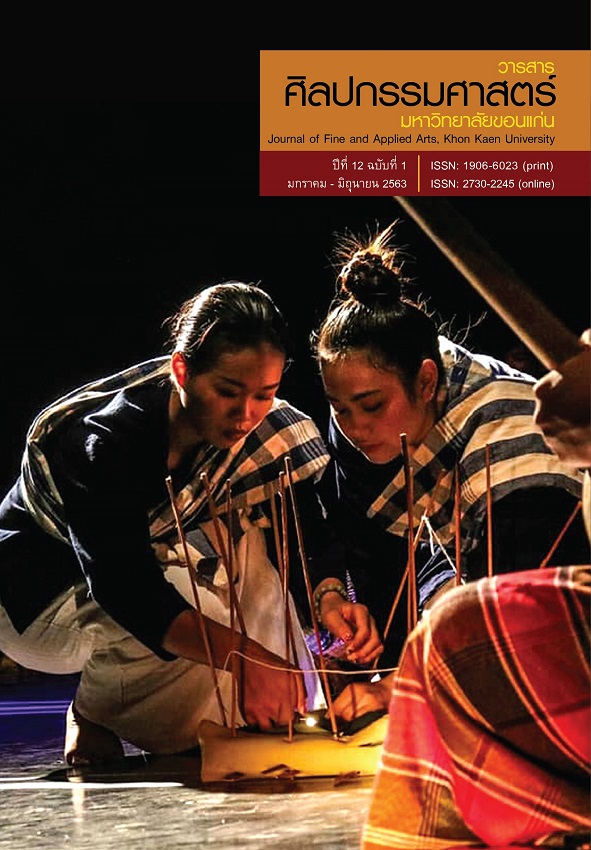Thai Guitarist’s Self-Directed Learning: a Case Study of Thammarat Duangsiri
Main Article Content
Abstract
This qualitative case study research aimed to investigate and analyze self-directed learning strategy of Thammarat Duangsiri, and present effective ways to build self-directed learning skill in 21st century for guitarists. This study was conducted using informal interview and participant observation to collect data. The results revealed that
1) self-directed learning strategy of Thammarat Duangsiri had a high level of self-directed learning ability. His strategies were as follows; conducting self-analysis, defining scope of target, managing his learning environment, and assessing his practices. He used those strategies in his learning until he could adapt to his own guitar playing style and create good works by himself. Technology was also a tool of learning used to develop essential skills and connect between learning and working, The factor affected his learning was environmental management, for instance, cleaning instruments constantly, building relationship with musicians and audiences through social media, and performing music activities to motivate self-learning. However, there are some barriers involved in self-directed learning. For example, teachers do no longer take a role as being facilitators, so it takes too much time in learning. This kind of learning also requires a high level of self-discipline, self-will and self-control.
2) Present effective ways to build self-directed learning skill in 21st century for guitarists pay more attention to methods and techniques to represent themselves with outstanding. Not only should they understand the differences of their roles in each works, but they also should learn from experiences, environments, and problems faced at work in the past to get better in the future.
Article Details
Content and information in articles published in the Journal of Fine and Applied Arts of Khon Kaen University is regarded as the opinion and sole responsibility of the author(s) directly; therefore, editors are not obliged to agree to or share any responsibility with regard to the content and information that appears within these articles.
All articles, information, content, image, etc. that have been published in the Journal of Fine and Applied Arts of Khon Kaen University is the copyright of the Journal of Fine and Appllied Arts of Khon Kaen University. Any person or organization who wishes to distribute all or parts of the articles for further dissemination or other usage must first receive permission from the Journal of Fine and Applied Arts of Khon Kaen University before proceeding to do so.
References
ชวลิต ชูกำแพง. (2550). การประเมินการเรียนรู้. มหาสารคาม: สำนักพิมพ์มหาวิทยาลัยมหาสารคาม.
ชัยยศ อิ่มสุวรรณ์. (2549). การเรียนรู้ด้วยตนเองเพื่อการศึกษาตลอดชีวิต. เดลินิวส์, 27.
ชาย โพธิสิตา. (2559). ศาสตร์และศิลป์แห่งการวิจัยเชิงคุณภาพ. พิมพ์ครั้งที่ 7. กรุงเทพฯ: อมรินทร์พริ้นติ้ง.
ณรุทธ์ สุทธจิตต์. (2538). หลักสูตรดนตรี. กรุงเทพฯ: สำนักพิมพ์แห่งจุฬาลงกรณ์มหาวิทยาลัย.
ณรุทธ์ สุทธจิตต์. (2541). จิตวิทยาการสอนดนตรี .พิมพ์ครั้งที่ 4. กรุงเทพฯ: สำนักพิมพ์แห่งจุฬาลงกรณ์มหาวิทยาลัย.
ทิศนา แขมมณี. (2552). ศาสตร์การสอน องค์ความรู้เพื่อการจัดกระบวนการเรียนรู้ที่มีประสิทธิภาพ.
พิมพ์ครั้งที่ 10. กรุงเทพฯ: ด่านสุทธาการพิมพ์.
นภเนตร ธรรมบวร. (2551). หลักสูตรการศึกษาปฐมวัย. กรุงเทพฯ: สำนักพิมพ์แห่งจุฬาลงกรณ์มหาวิทยาลัย.
นฤมล บุญส่ง. (2561). สื่อสังคมกับการเรียนการสอนในศตวรรษที่ 21. วารสาร Veridian E Journal มหาวิทยาลัยศิลปากร, 11(1), 154.
ปราชญ์ อรุณรังษี. (2544). การฝึกอย่างมีประสิทธภาพ พัฒนาการสูงสุดโดยใช้เวลาน้อยสุด. Overdrive, 3, 29.
วรชาติ กิจเรนู. (2547). การวิเคราะห์แนวทางการเล่นกีตาร์ของผู้ได้รับรางวัลชนะเลิศจากการประกวดโอเวอร์ไดรฟ์ กีตาร์คอนเทส ครั้งที่ 4. วิทยานิพนธ์ปริญญาศิลปศาสตรมหาบัณฑิต สาขาดนตรีศึกษา วิทยาลัยดุริยางคศิลป์ มหาวิทยาลัยมหิดล.
วิจารณ์ พานิช. (2555). วิถีสร้างการเรียนรู้เพื่อศิษย์ในศตวรรษที่ 21. กรุงเทพฯ: มูลนิธิสดศรี-สฤษดิ์วงศ์.
สมบูรณ์ ศาลยาชีวิน. (2526). จิตวิทยาเพื่อการศึกษาผู้ใหญ่. เชียงใหม่: ลานนาการพิมพ์.
สำนักงานบริหารงานการมัธยมศึกษาตอนปลาย [สพฐ]. (2558). แนวทางการจัดการเรียนรู้ในศตวรรษที่ 21 ที่เน้นสมรรถนะทางวิชาชีพ. กรุงเทพฯ: โรงพิมพ์ชุมนุมสหกรณ์การเกษตรแห่งประเทศไทย.
สุภางค์ จันทวานิช. (2552). การวิเคราะห์ข้อมูลในการวิจัยเชิงคุณภาพ. พิมพ์ครั้งที่ 9. กรุงเทพฯ: สำนักพิมพ์แห่งจุฬาลงกรณ์มหาวิทยาลัย.
สุรางค์ โค้วตระกูล. (2548). จิตวิทยาการศึกษา. พิมพ์ครั้งที่ 12. กรุงเทพฯ: สํานักพิมพ์แห่งจุฬาลงกรณ์มหาวิทยาลัย.
Burner, J. (1993). Schools for learning. Cambridge: MIT Press.
Kolb, A. (1984). Experiential Leaning: Experience as the Source of Learning and Development. Englewood Cliffs, NJ: Prentice Hall.
Partnership for 21st century skills. (2009). P21 framework definitions document. Retrieved March 29, 2018, from http://www.21stcenturyskills.org/documents/p21_framework_ definitions_052909.pdf on April 2018
Prensky, M. (2008). The role of technology in teaching and the classroom. Educational Technology, 48(6), 64.
Treffinger, J. (1995). Creative problem solving: Overview and educational implications. Educational Psychology Review, 7(3), 301–312.


